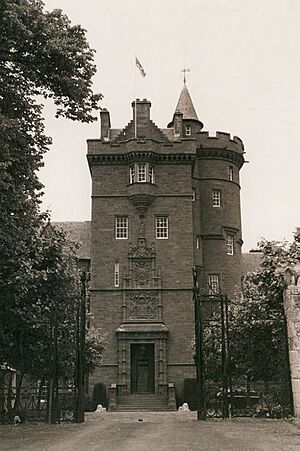Beaufort Castle, Scotland facts for kids
Beaufort Castle or Castle Dounie (Scottish Gaelic: Caisteal Dhùnaidh) is a large, historic mansion in Scotland. It was built in 1880, but it includes parts of much older buildings. You can find it on the right bank of the River Beauly, near the town of Beauly in Inverness-shire. It's about 1 mile north of Kiltarlity and 13 km (8 mi) west of Inverness. There has been a castle on this spot since the 1100s! Beaufort Castle is the traditional home of the Lords Lovat. They are the leaders of the Clan Fraser of Lovat.
Contents
A Look Back: Castle History
The first time this place was mentioned was as Downie or Dounie Castle. This was during the time of King Alexander I (1106–1124). Records show that a siege happened here back then. The first castle was built by the Byset family. Later, in the late 1200s, the Frasers took over the castle. English forces attacked the castle in 1303.
In the 1650s, Dounie Castle was attacked and burned. This happened when the forces of Oliver Cromwell invaded Scotland.
The Fox and the Jacobite Cause
The Fraser family lands were passed down to Simon Fraser, 11th Lord Lovat in 1699. He was known as 'The Fox'. Lord Lovat became very involved in the Jacobite cause. This was a movement to bring the old royal family, the House of Stuart, back to the thrones of Scotland and England.
Lord Lovat went to France and joined James Francis Edward Stuart, who was known as the Old Pretender. He even became a Catholic. He tried to get Scottish nobles to join the Jacobite cause. He carried secret messages to Scotland. But his actions led to him being jailed in France for ten years.
Rebuilding and Reclaiming the Castle
When he returned in 1714, Lord Lovat seemed to give up the Jacobite cause. In return, he got his lands back. In the 1740s, he asked a famous architect, William Adam, to design a new house at Dounie. This was Adam's last project. However, only the stone for the building was delivered. Construction never started because the Jacobite Rising of 1745 began.
Lord Lovat changed his mind again and supported the Jacobites. But he was captured and executed after the Battle of Culloden. Dounie Castle was then destroyed by the Duke of Cumberland. The government took over the Fraser family's lands.
From 1746, the government managed the estate. A small house was built where the castle used to be. This house was for the estate manager. In 1774, the estate was given back to Lovat's son, Simon Fraser of Lovat. He had led the 78th Fraser Highlanders for the British Army. Ideas for a new house were suggested in 1777, but they were not built.
In 1815, Thomas Fraser inherited the estate. He became Lord Lovat again in 1854. In 1839, he hired William Burn to make the house bigger. He also improved the castle grounds. His son, Simon Fraser, 13th Lord Lovat, built the Beaufort Castle we see today. He used designs by James Maitland Wardrop and included parts of the 1700s house.
In 1994, the castle was sold to Stagecoach director Ann Gloag. This was done by the 15th Lord Lovat to help pay taxes.
What Does Beaufort Castle Look Like?
Beaufort Castle is built in a style called Baronial. It has its own private Roman Catholic chapel. You can still see the remains of the old Dounie Castle next to the house. It's just a single wall, about 11 meters (36 feet) long and 1.5 meters (5 feet) high. A plaque there says it is "the ruin of Castle Downie, the ancient stronghold of the Frasers of Lovat, built around 1400, and destroyed by Cumberland after the battle of Culloden."
The house is a very important historic building. It is a category A listed building. The castle grounds are also special. They are included in the Inventory of Gardens and Designed Landscapes. This is a national list of important gardens in Scotland.



